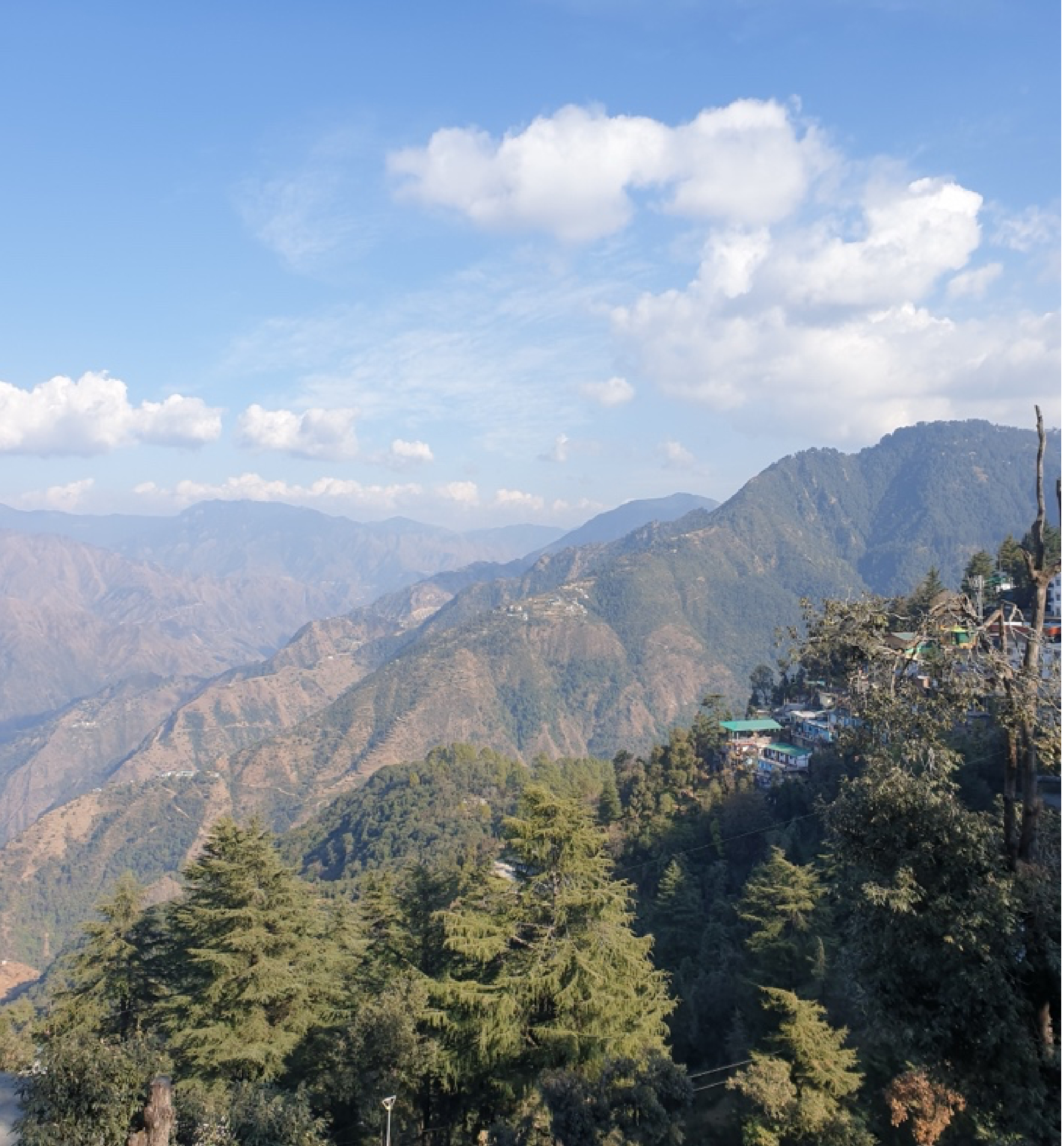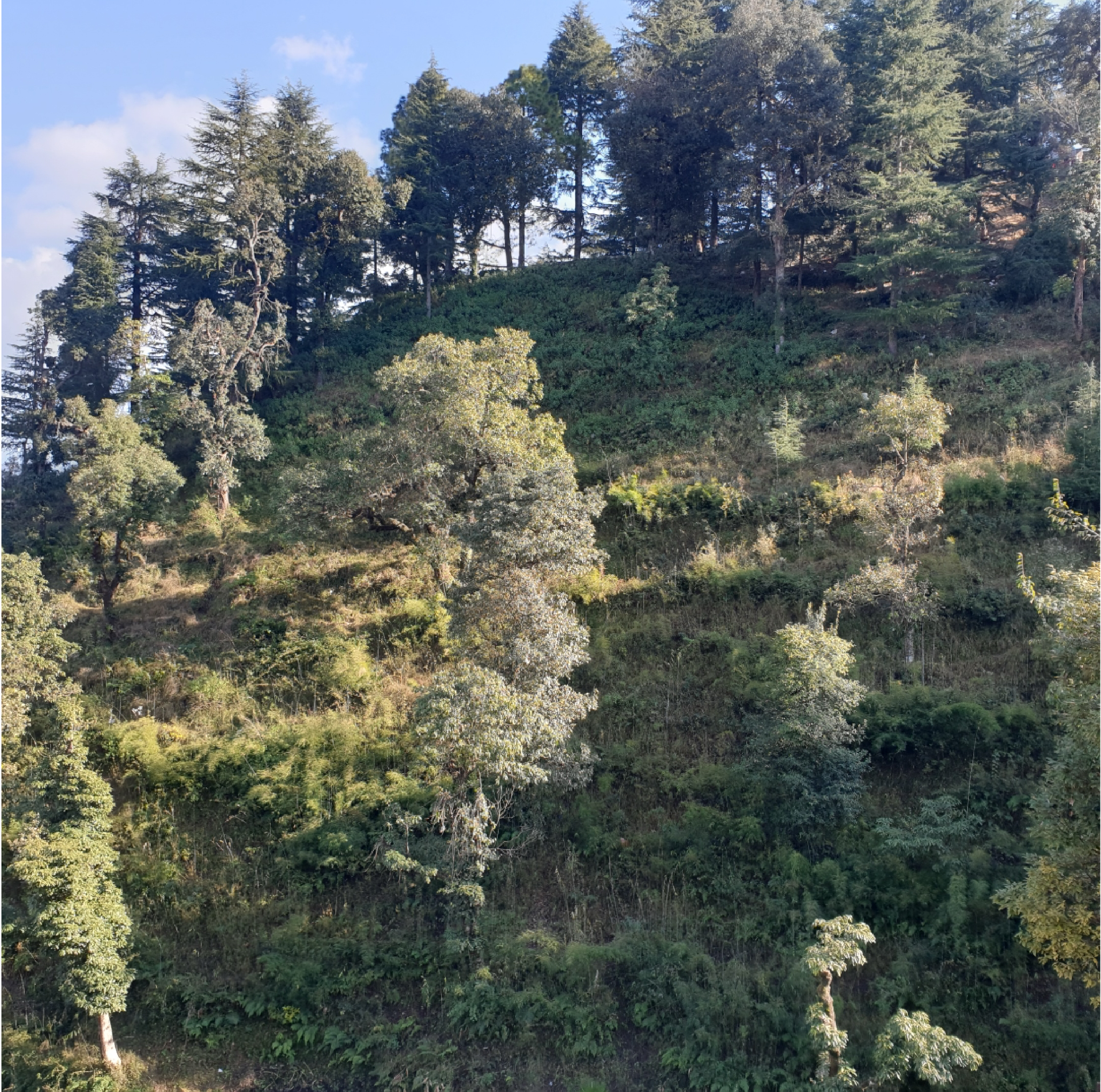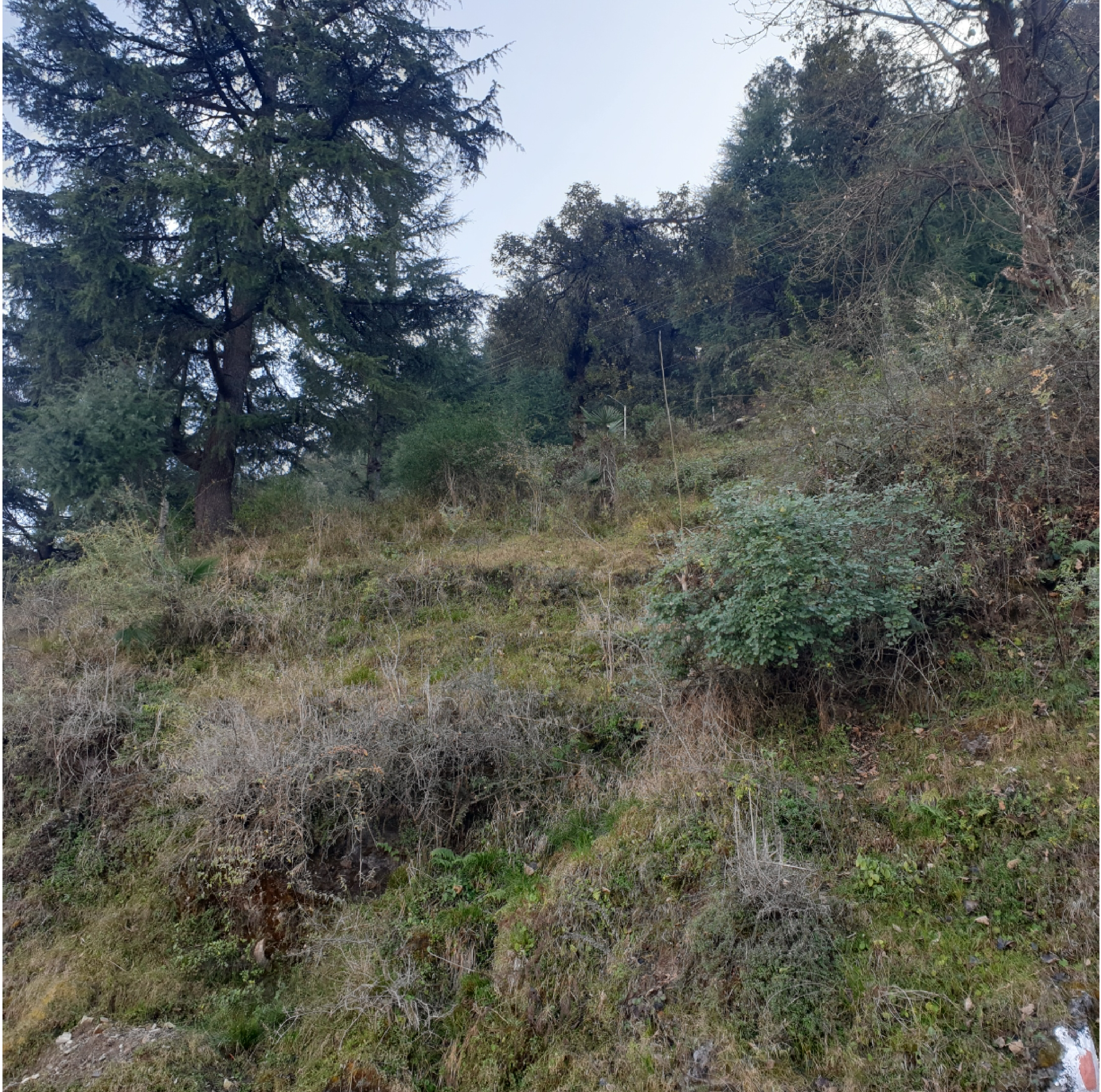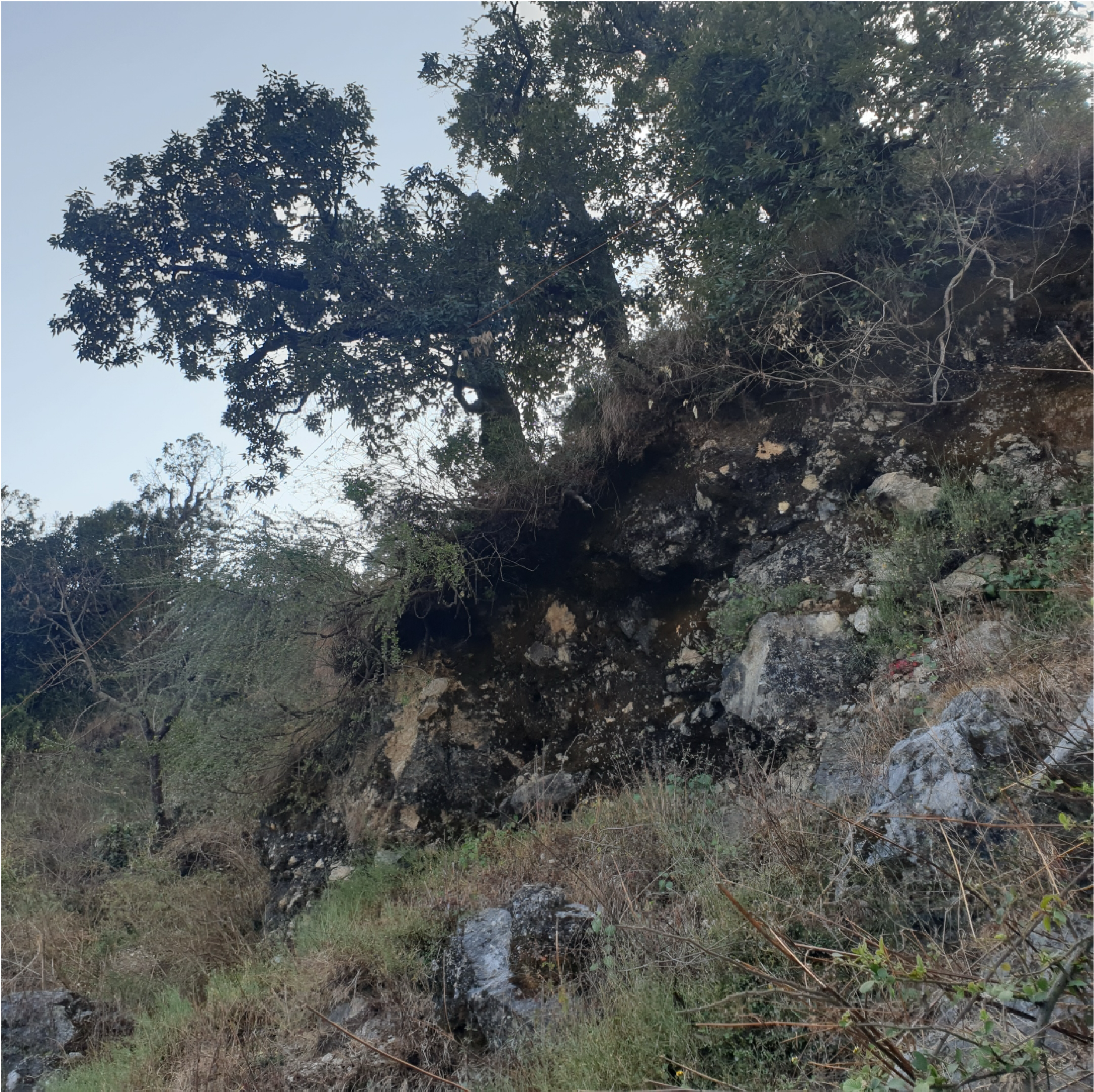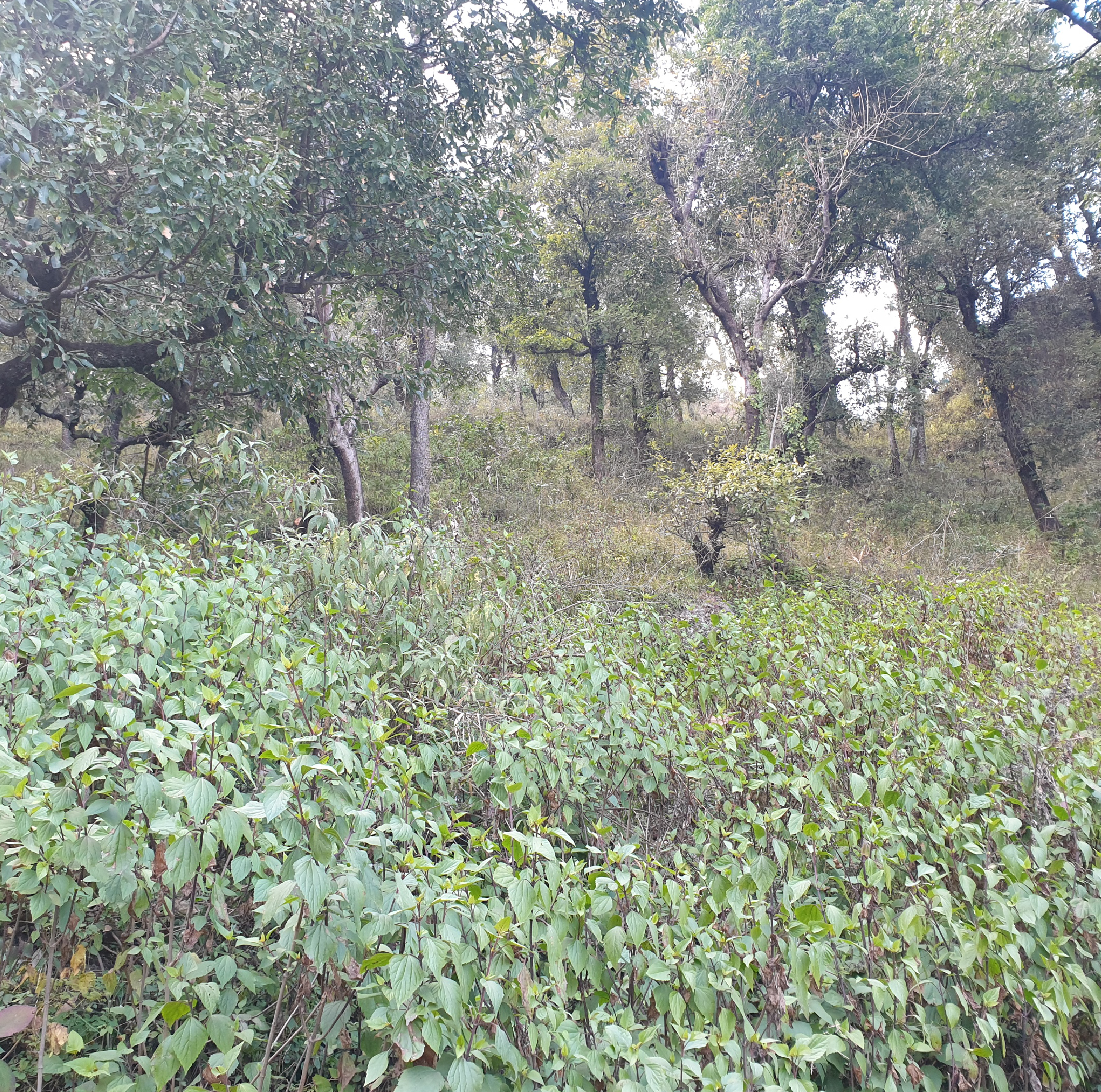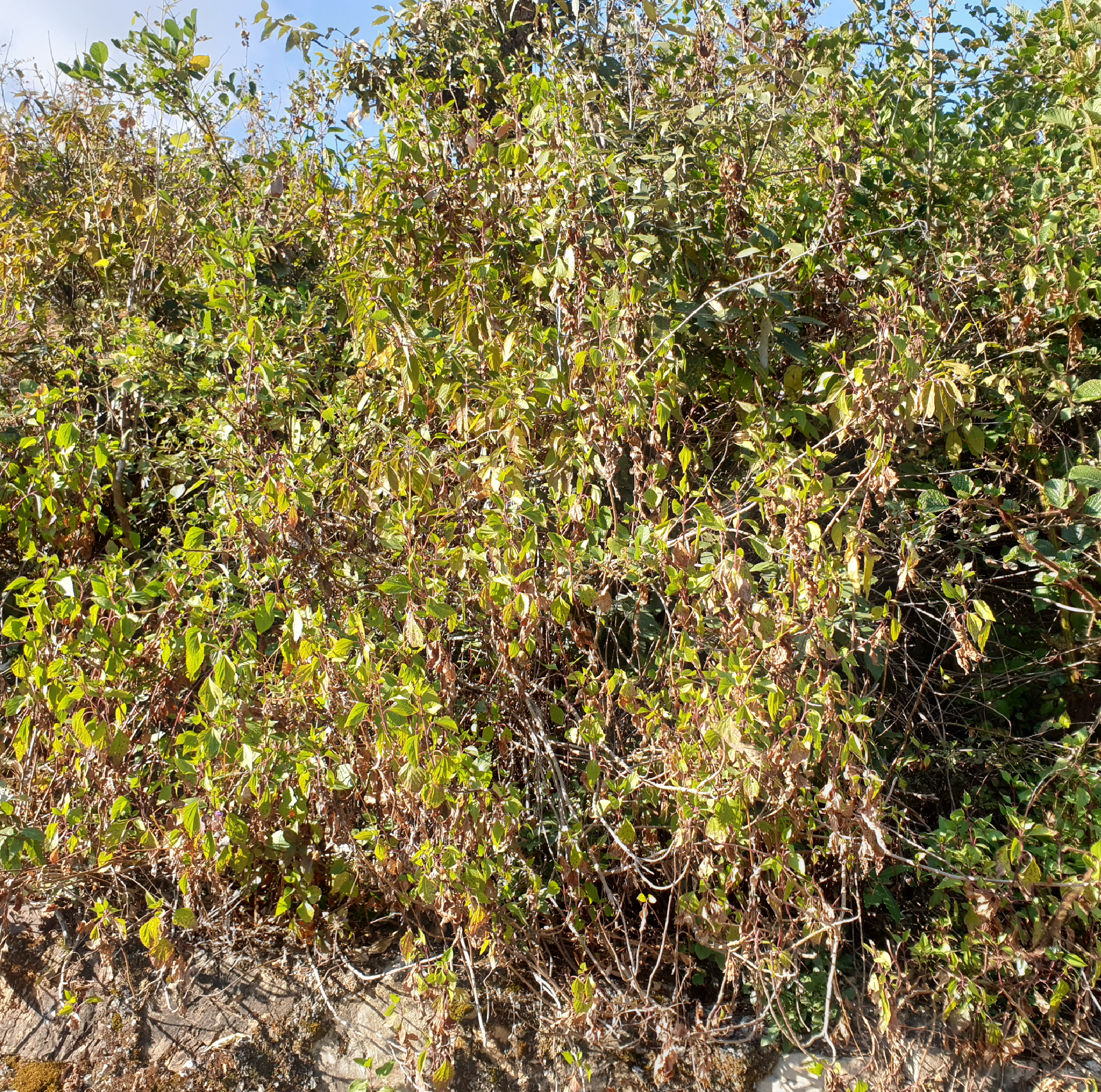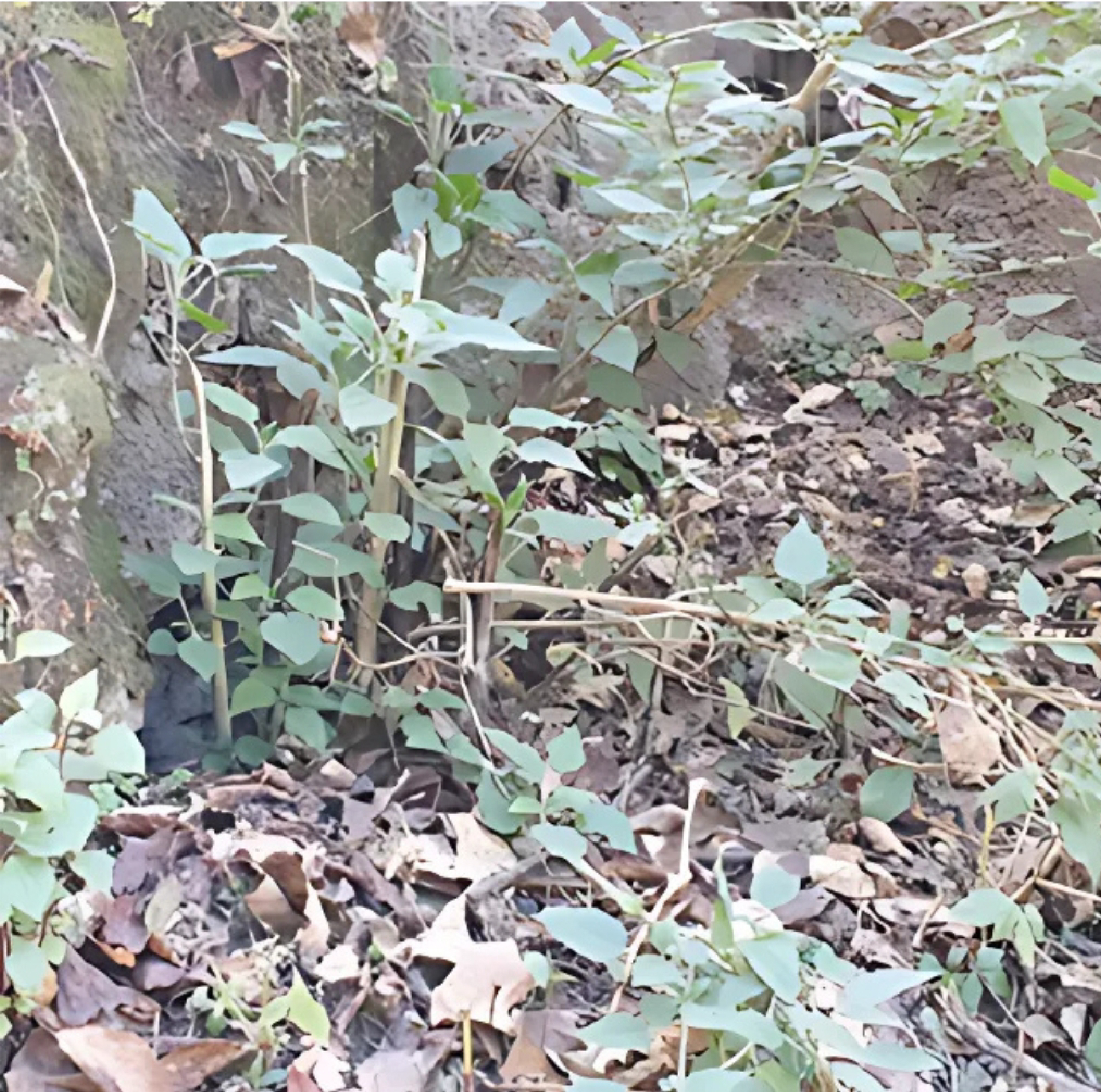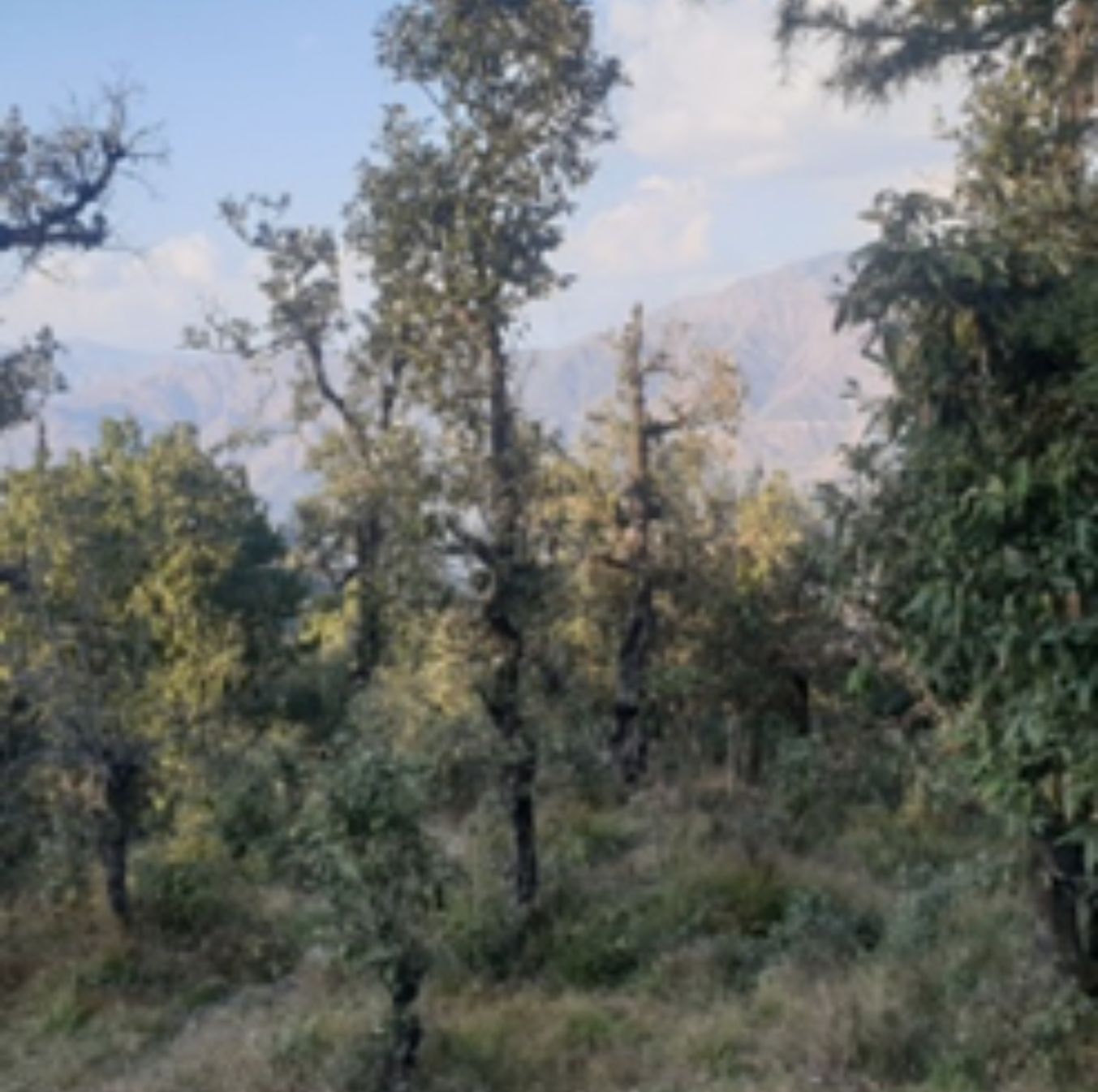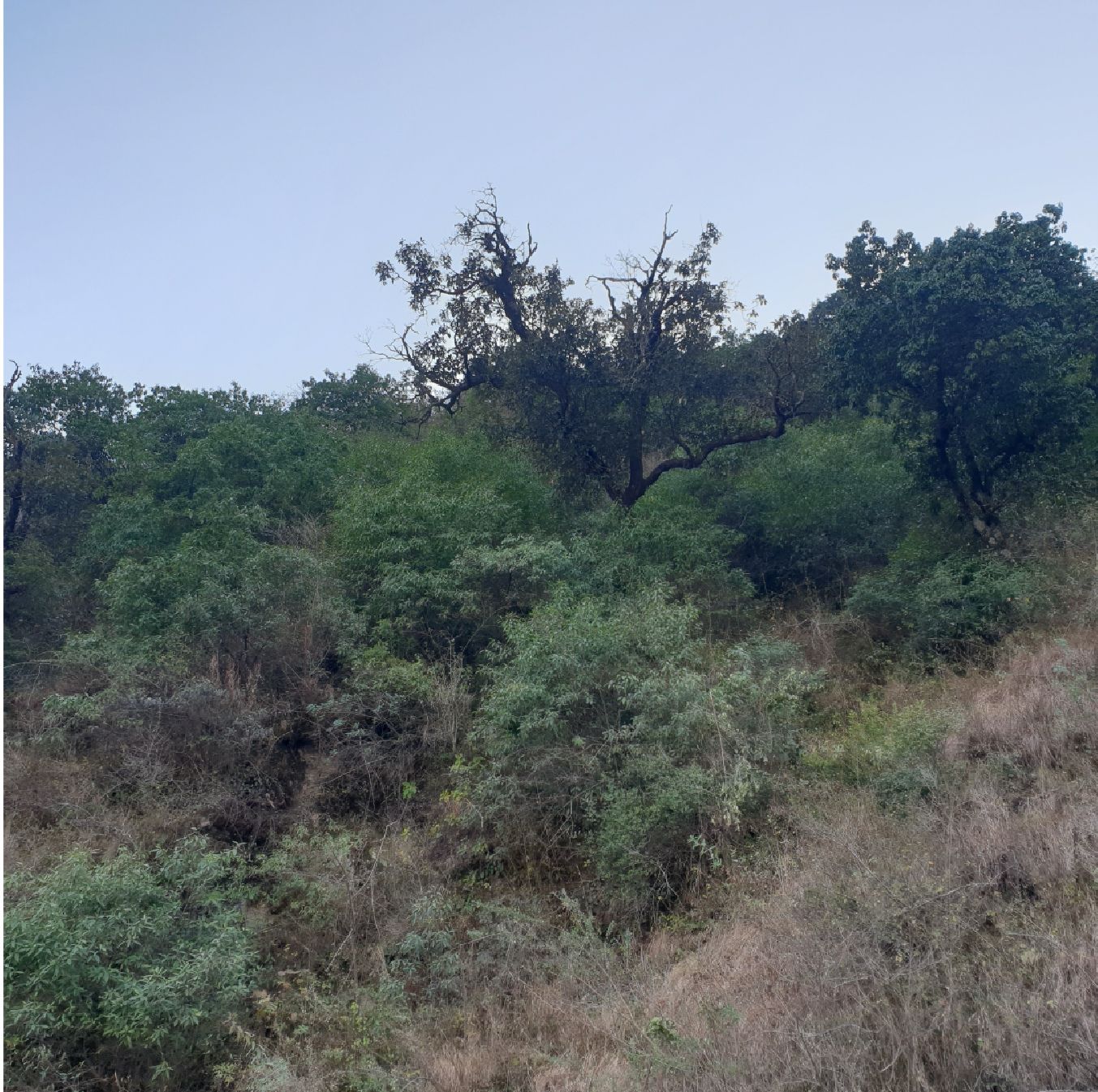When Old Patterns Stop Making Sense: Shifts in Western Himalayan Plant Assemblages, 2020-2024
by Sudipto Majumdar, Pragya
The first signs of change were not spotted by scientists. They were noticed by people who walk these slopes every day. Women collecting
Ajwain (Trachyspermum ammi), herders gathering
fodder & men pruning terrace
edges. They noticed small but telling absences in their environment. The small, useful herbs that used to grow in the fields along bunds, near terraces & between crops had started to disappear. These included Trifolium repens and Medicago lupulina for fodder, and even Ajwain, the spice that flavours several local foods, which had once thrived in bund crevices and terrace risers. In their place came coarse, wiry colonisers and bitter, fast-spreading
invasives. Lantana camara, Ageratina adenophora, and Parthenium hysterophorus began appearing
in clusters where farmers once gathered medicine or fodder. These are not just unfamiliar plants but culturally out of place for being non-palatable & non-medicinal.
Many of these shifts echo
broader range transitions observed in mid-altitude ecotones across the Western Himalaya, where thermophilic (heat-loving) and
ruderal (disturbance-adapted) species now dominate microhabitats that were once shaded & moist but are increasingly dry & open. The shift in plant cover they are witnessing has a deeper
unravelling of known patterns very much revered amongst ecologists. Seasonal
cues had grown unreliable since the hills are warming early. Pre-monsoon showers have become erratic & long dry spells stretch
into what used to be moist months.
Forest fires are now common
in belts where they were once
rare, especially above 1800 metres. As these stressors converge, plant assemblages that held together for decades
are breaking up. Where known herbs and legumes once grew, hardy colonisers & invasive species are
now taking over. In fire-affected zones, soil pH had shifted upward, due to ash deposition after the surface litter burns out, a spike that fades away but not until invasive species have moved in. These areas also showed a near-complete disappearance of
litter-binding herbs like Leucas & Plantago, whose loss is likely to
accelerate runoff
& reduce topsoil retention in early monsoon phases. These shifts also
correlated with fire exposure, cattle tread, and observable soil changes,
specifically reduced organic matter and increased compaction in bund toes and terrace risers.
From 2020 to 2024, we carried out biodiversity & habitat monitoring studies in districts of Chamoli, Uttarkashi, and Chamba in the western Indian Himalayas. These covered ecotones between 1320 and 1950 metres and targeted microhabitats like nala-fed gullies, bund drop-offs, springfed terraces & degraded ridges. Taking lead from the community reports, elevational shift analysis was conducted by quadrat-wise altitudinal centroids for 8 focal herbs: Trachyspermum ammi (Ajwain, native aromatic and medicinal herb), Ajuga bracteosa (Neelkanthi, native midslope medicinal herb used in skin and respiratory remedies), Swertia chirayita (Chirayita, high-altitude bitter herb of medicinal and cultural value), Urtica dioica (stinging nettle, native leafy perennial herb used for food and fibre) and Parthenium hysterophorus (Congress grass, aggressive invasive herb with known allelopathic effects), Lantana camara (woody, thorny invasive shrub with allelopathic properties and fire-prone growth habit), and Ageratina adenophora (Crofton weed, aggressive invasive Forb, dominant in disturbed mid- to lower-elevation slopes with dense cover & allelopathic effects) each with 100 replicates.
To identify medicinal species and observe the changes in their populations and their habitats we established 300 1 × 1 m quadrats along 23 belt transects, tracking shifts in species composition, phenology, and vegetation structure across microhabitats. These were supplemented by detailed conversations with community elders, whose insights on changes in leaf flush timing, plant smell, and root texture often served as early indicators of species loss or upslope movement. Their observations helped interpret not just presence or absence, but changes in phenological windows (timing of life cycle events), altered associations among species, and signs of functional turnover in the plant community. To quantify these patterns, we used relative abundance across all quadrats. Species compositional shifts were tested using Mann-Whitney U-tests & Kruskal-Wallis for slope and aspect classes. Range shifts were assessed via altitudinal centroid tracking between 2020 & 2024. Differences were considered significant at p < 0.05. All quadrats were georeferenced (±5 m) and linked to aspect & slope gradient metadata.
A typical mid-altitude Himalayan terrain with steep southern slopes
dominated by Chir pine (Pinus roxburghii). Most visible habitats,
including settlements and forest patches, are encircled by
expanding pine cover. This widespread pine dominance especially
on sun-facing slopes has important implications for fire risk, soil
moisture retention, native biodiversity, and regeneration of
broadleaf species. Spreading pine cover means greater understory
accumulation of flammable litter which drives vegetation change.
The results
showed consistent upslope range shifts
of medicinal herbs: Ajwain has moved higher by over 300 m, no longer seen below 1500 m in Kalauta (Chamba district, 1400-1500m). The mean upslope shift between 2020 and 2024 was 301.6 m. Similarly, Valeriana jatamansi
(Tagar), a much-valued medicinal herb, found in shaded forest
pockets is now absent from lower homestead zones (below 1650 m) where it was once
being very common, and is only found in moist upper corners
of oak-pine patches
above 1800 m, often in low-
canopy pockets protected from surface
heat. Ajuga bracteosa has
also moved upslope.
It was once common along old field walls & orchard
fringes near Kalauta,
but is now only seen above 1866 m. Ajuga prefers shaded, less-trampled trailbanks &
micro-sites now more frequent upslope, as mid-slopes have dried & degraded.
These shifts in
elevation are driven by habitat squeeze because viable zones have shrunk,
pushing these species into narrower upslope
refuges. These are consistent with temperature-linked phenological displacement observed in
other temperate herb species, possibly accelerated by declining under-canopy moisture
and soil crusting. Thus, Ajuga and Valeriana exhibit the highest upslope ratesamong all observed taxa (mean 6.5-7.8
m/year), with consistent vertical displacement across
both southern and northern aspect
belts.
Ageratina adenophora is now advancing into mid-elevation oak forests once considered
resistant to such invasion. In field plots like this one, Ageratina covers over 60-80% of the
ground layer in some 1×1 m quadrats, with visible suppression of native herbs like Trifolium,
Vigna & Geranium. Community members note that this patch remained free of Ageratina a
few years ago but now shows rapid spread following canopy opening and past fire events.
The understorey here is becoming increasingly homogenous & litter decomposition has
slowed, with drier, matted layers observed across the slope. In Ageratina-invaded oak
patches we observed bulk density rise to 1.42-1.56 g/cm³ (vs. 1.18–1.26 g/cm³ in intact
areas) & soil organic carbon drop to 0.58% (from 0.92-1.15%). Litter decomposition is
generally not very slow but the shear volume of it overwhelms the native herbs while
Ageratina itself does very well under these induced conditions.
Across the ridge & mid-slope ecotones in
Sidoli and Kwarit (Chamoli district, 1500-1800
m), moisture-loving Quercus leucotrichophora belts now record drought/fire-tolerant Pinus roxburghii (Chir pine) saplings in 30- 35% of plots. These belts had near-zero Chir in forest maps before 2015. It signals a possible regime shift toward fire-adapted canopy types, reinforced by pine needle accumulation, drier soil surfaces & heat- facilitated seedling survival. Plot metadata from Pilang (Chamoli district, 1380-1680 m) and Sidoli further confirms Chir seedlings establishment co-occuring with Eragrostis nigra
& Parthenium
hysterophorus which dominate post-fire trailbeds
& compacted edges. We now consider this a landscape-scale structural transition,
with Chir oak inversion patterns
confirmed via forest-type boundary reclassification between
2015 and 2024. Some species are riding this change and are expanding
their altitudinal range by creeping
upslope. For
example, ruderal disturbance-loving Parthenium
hysterophorus & Urtica dioica have
expanded their elevational range and now also
seen in higher
reaches (92.9 m and 51.0 m on average between
2020 and 2024).
Healthy forest floor ground cover is
essential for nutrient cycling, soil stability,
and native regeneration. In this patch, it has
been largely replaced by Lantana camara,
an invasive shrub forming a monodominant
understorey. The litter layer is thick but
poorly decomposed, signalling low
microbial activity. Dry, compacted soil with
low organic content further reflects
ecological decline and limits the return of
native herbaceous species.
Species abundance also displays a statistically
significant decline (in more than 60% of quadrats) in native herbs and legumes, paired with a rise in graminoid (grass family) colonisers (Cynodon, Eragrostis, Setaria) and invasive species, particularly along bund crests
and scraped margins,
suggesting a shift
towards shallow- rooted, disturbance-favoured assemblages. Abundance ratios showed a 2.7-fold rise in graminoid presence
post-2021, primarily driven by Eragrostis spp. and Cynodon dactylon, which replaced former legume- dominated
ground layers such as Trifolium
repens & Medicago
lupulina. In Silagrath
(Chamoli district, 1420- 1600 m), populations of Berberis aristata, a medicinal herb, fell dramatically (from 7.4% to 1.8% mean relative abundance) across trails below 1450 m and were absent in around 80% of its previously recorded quadrats. In the same patches, the invasive species Lantana camara and Ageratina adenophora rose to over 22% combined coverage,
and the non-native grasses Eragrostis
nigra & Cyperus
rotundus dominate with >35%
ground coverage. In adjacent degraded
fields, soil-enriching native herbs such as Trifolium repens, once abundant, are now rare (present in 85% of quadrats in 2020, now in only 23%) implying a loss of nitrogen-fixing
soil organisms. Across
fire-affected ridge zones between 1550-1800 m in Chamoli (Pilang-Dungra belt) and Chamba (Kalauta-Sidoli belt), Lantana camara (more than 50% coverage in some plots) and Ageratina (up 20%) have expanded between 2021 and 2024. In Pilang, native legumes like Medicago lupulina declined by 78% (in 147 quadrats). Once common in moisture-retaining bund zones and shaded stone margins, they appear only in fragmented clumps
today, mostly below terrace risers. Field teams recorded a 63% replacement of low-growing legumes by wiry
colonisers like Cynodon dactylon and Cyperus rotundus, with mean abundance of legumes dropping by nearly 40%. These trends indicate replacement of native herbs by
invasive competitors that disproportionately benefit from fast colonisation dynamic driven by soil exposure
and moisture stress, with
opportunistic graminoids taking hold
in once-legume-dominated areas. A lot
of this is due to changes in soil- increased compaction and reduced
nutritional content (soil bulk density in Eragrostis-dominated plots was 1.4–1.6 g/cm³,
beyond compaction
threshold for root penetration, and soil Organic Matter levels were below 1.2%). Soil organic matter was
significantly lower (by 27.8%) and pH higher (by 0.36 units) in fire-affected zones compared to intact forest-edge control sites. Agricultural patches and fire- affected zones showed soil compaction near bund toes and nitrate leaching in post-harvest zones, suggesting that both water
retention and nutrient cycling are being compromised, and that nutrient loss and compaction are jointly driving these assemblage shifts [significant differences in both soil OM and nitrate-N of fire-affected & scraped zones, when compared with intact zones (χ² = 14.5, p < 0.01)] in favour of disturbance-adapted invaders, which outcompete & limit regeneration niches for native species.
In Gaila (Chamba district, 1350-1500 m), a bamboo-like grass, identified in the field as Arundinella bengalensis
or a Pogonatherum species- not recorded during surveys in 2018-2019, now covers 34% of plots along
degraded terrace edges & abandoned bund margins. It is unpalatable, spreads by basal tillers, and dominates
post-fire and cattle-tread zones. Communities call it “nangal ghaas” and associate its spread with soil scraping
and fire. Its basal spread indicates rhizome-driven expansion which better utilises the soil nitrogen in disturbed
sites, especially in areas with footfall compaction or exposure post burning. Sampling from 2024 shows basal
cover ratios >60% for Arundinella in >40% of fire-exposed quadrats, confirming its role in post-disturbance
dominance. Species richness in these belts has more than halved (avg. 9 species/ m² pre-2020, now below 4).
Across Chamoli and Uttarkashi, Urtica dioica has increased by more than 40% (in 68 plots), replacing herbs
like Viola and Leucas in trail-edge and scrub zones. Parthenium hysterophorus now forms monocultures with over 60% coverage in Ranbirpur (Uttarkashi district, 1440 m).
These shifts may stem
from nutrient pulses (temporary nitrogen surges in runoff collection zones due to
sediment inflow from burnt sites with loose soil) are contributing to niche openings for
aggressive ruderal taxa. Soil profiles in Parthenium-dominated plots also showed
elevated nitrate levels, because of runoff pouring in. Spatial modelling confirmed the
expansion zones of Parthenium closely matched low-lying moisture catchments & bund
breaches with visible sediment accumulation.
“Earlier we had to
search for Bicchu
Buti (Urtica
dioica). Now it
grows where the
goats walk.”- goat
herders
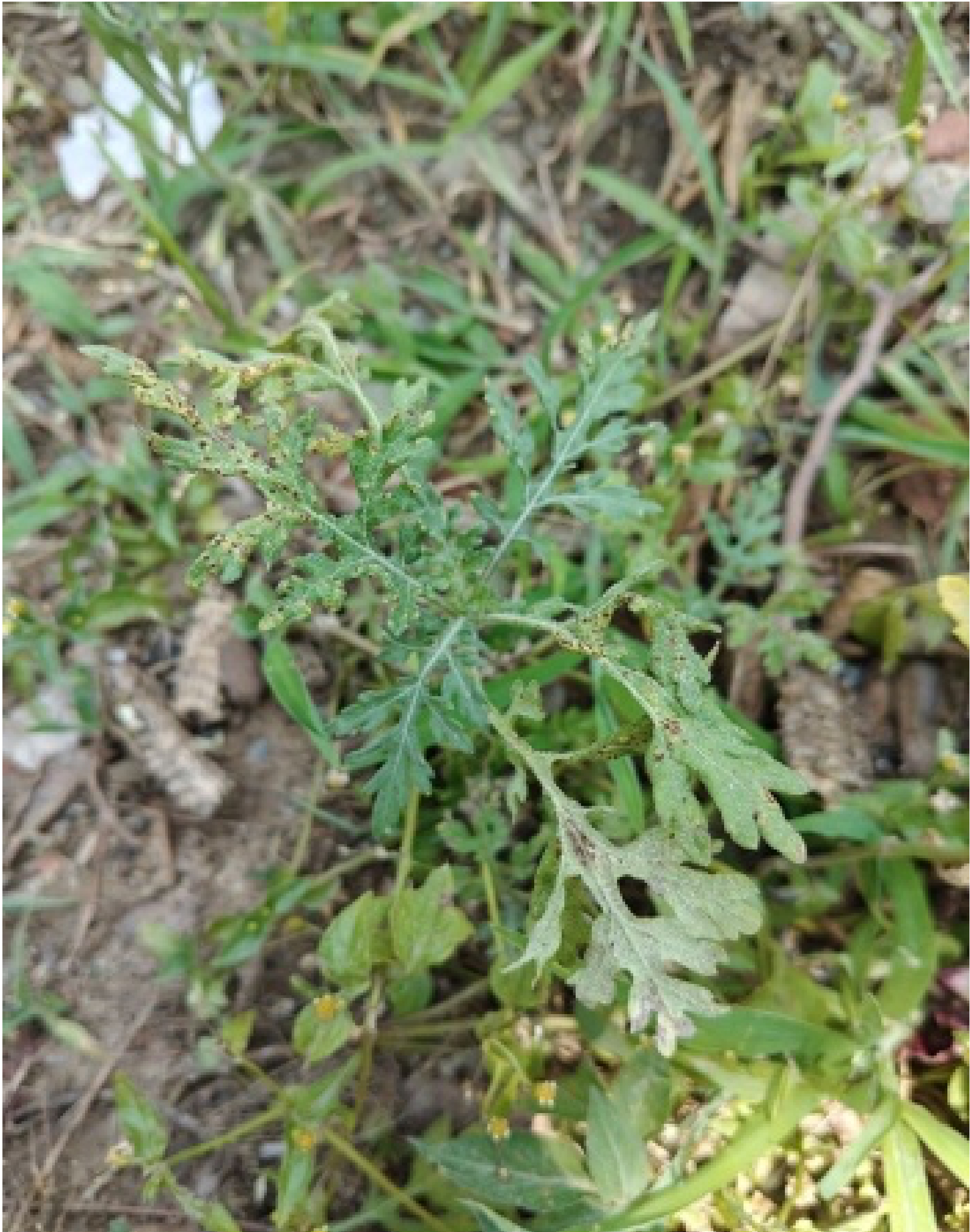
Parthenium hysterophorus
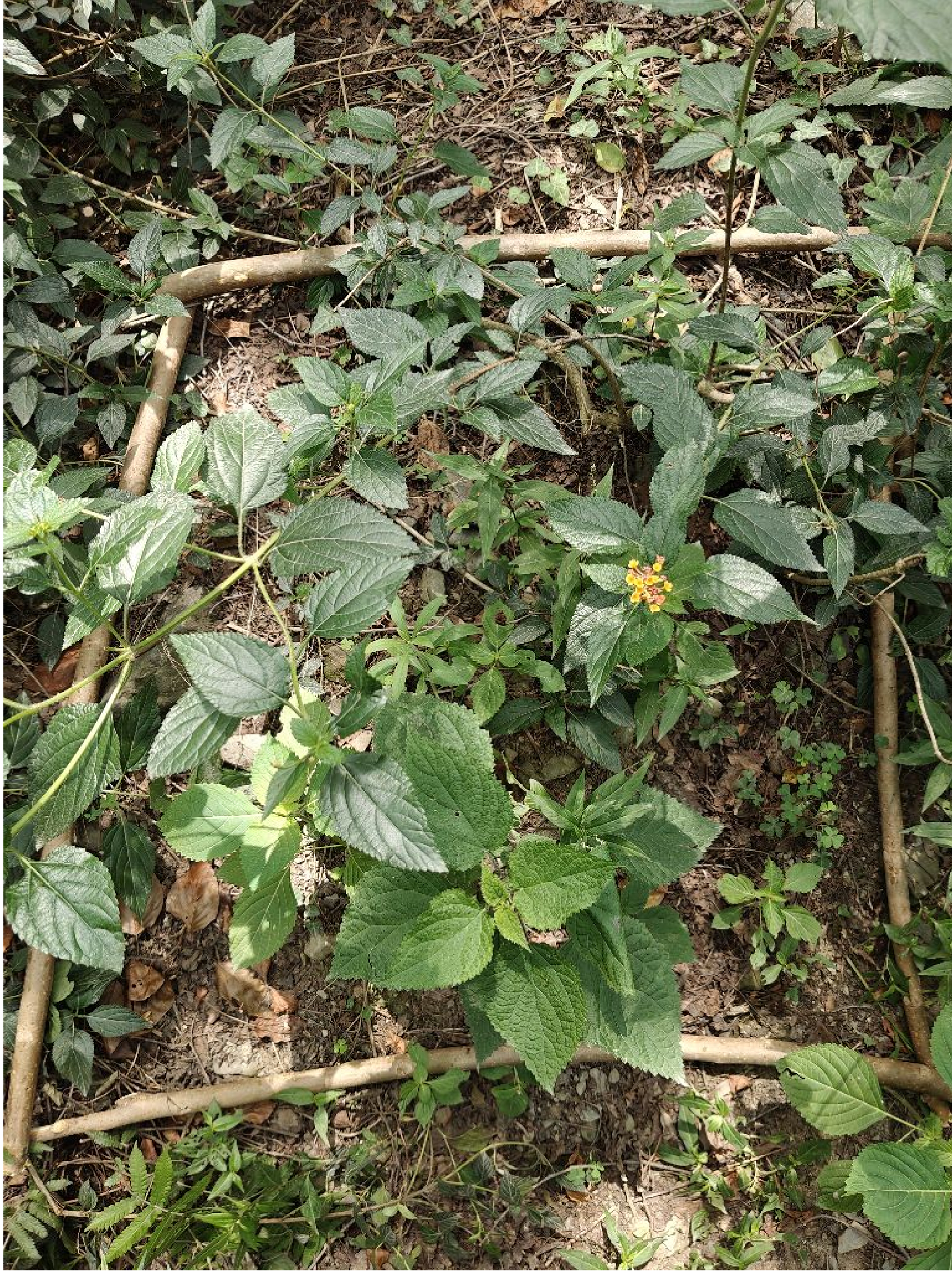
Lantana camara
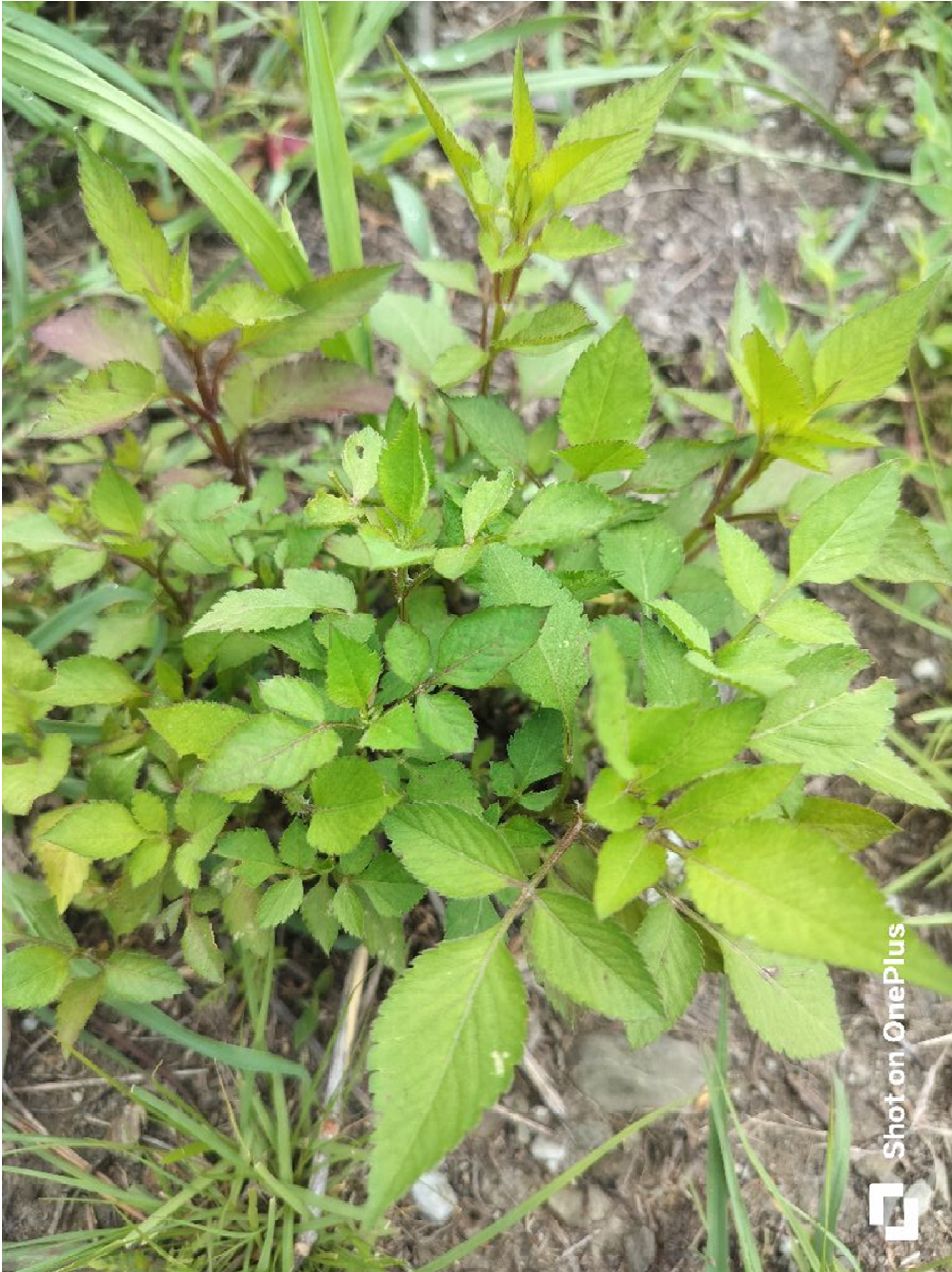
Ageratina adenophora
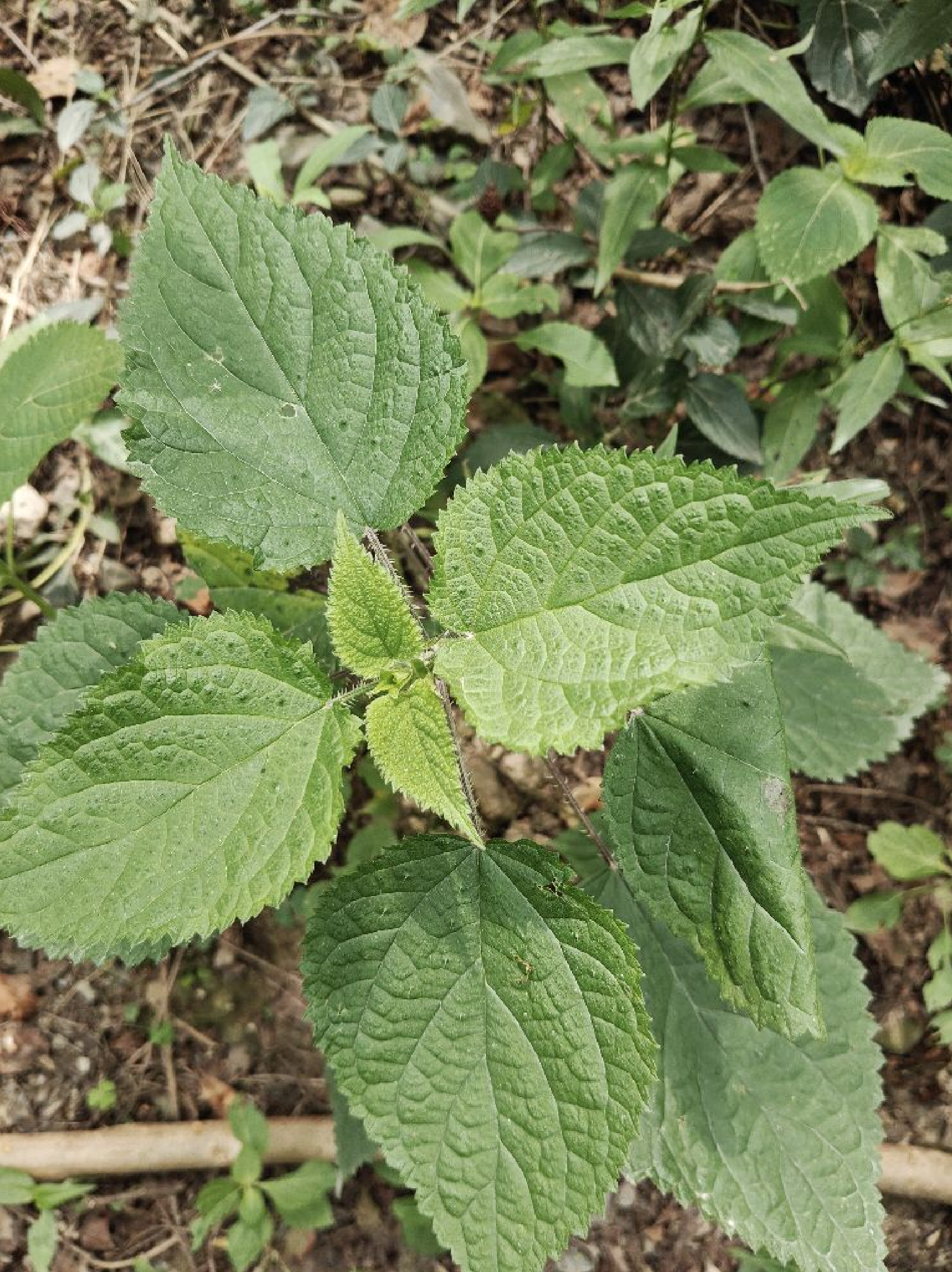
Urtica dioica
These quadrats reflect the ongoing shift in understorey composition across disturbed mid-Himalayan forest sites. Dominant species include
Ageratina Adenophora, Lantana camara, Urtica dioica & Parthenium hysterophorus. All of these are generalist, disturbance-adapted (ruderal)
species expanding their range uphill. Their aggressive spread is associated with canopy thinning, past fire events & soil degradation. These plants
form dense, monodominant stands that displace of native herbs like Trifolium, Vigna & Geranium which require cooler & undisturbed
microhabitats. Soils in these quadrats are typically dry, compacted & low in organic carbon with poor litter decomposition. These new dominants
thrive in these exposed, degraded patches, limiting floristic diversity and reducing habitat suitability for pollinators and soil organisms. Species
richness in these plots is visibly low, with 1-3 species per 1×1 m quadrat, often with a declining trend in native herb abundance with increasing
density of these species.
Several
native herbs now show compressed growth periods and altered reproductive timing. Trachyspermum ammi (Ajwain) flowers
earlier- in Pilang,
it initiated flowering approximately 18.5 ± 2.7 days earlier than the 2010-2015
baseline, with first blooms recorded
in early April
instead of the typical late April–
early May window; the flowering phase also concluded prematurely by late May, nearly
35 ± 4.2 days earlier than the historical July
endpoint. This phenological acceleration coincided with its complete
disappearance below 1500 m in Kalauta,
suggesting both thermal
sensitivity to spring warming
& altitudinal contraction due to failure to complete its reproductive cycle at
lower elevations. Ajuga bracteosa displays
a significantly shortened flowering
duration- in upper Kwarit (above 1866 m),
its inflorescences persist for 20.8 ± 3.4 days which earlier
was 42.1 ± 5.1 days; concurrently, its post-May vegetative growth declined noticeably along with reduced
leaf health. Here we see both a shorter blooming period and weaker plant growth
after flowering, suggesting seasonal stress or nutrient drawdown following early flowering. In Dungra, Swertia chirayita
started sprouting nearly
3 weeks later than usual,
with first shoots
showing up only around mid-May
instead of late April. On exposed ridges, flowering
was patchy & sparse, and in Silagrath, it was off by over two weeks and
didn’t match the oak leafing like it always used to, which local harvesters
used as a timing cue. Plot records between 2020 and 2024 confirm
that first blooming
has shifted nearly 18 days earlier than it used to between 2010 and 2015. Trifolium repens too has a shorter cyclein
Dungra,
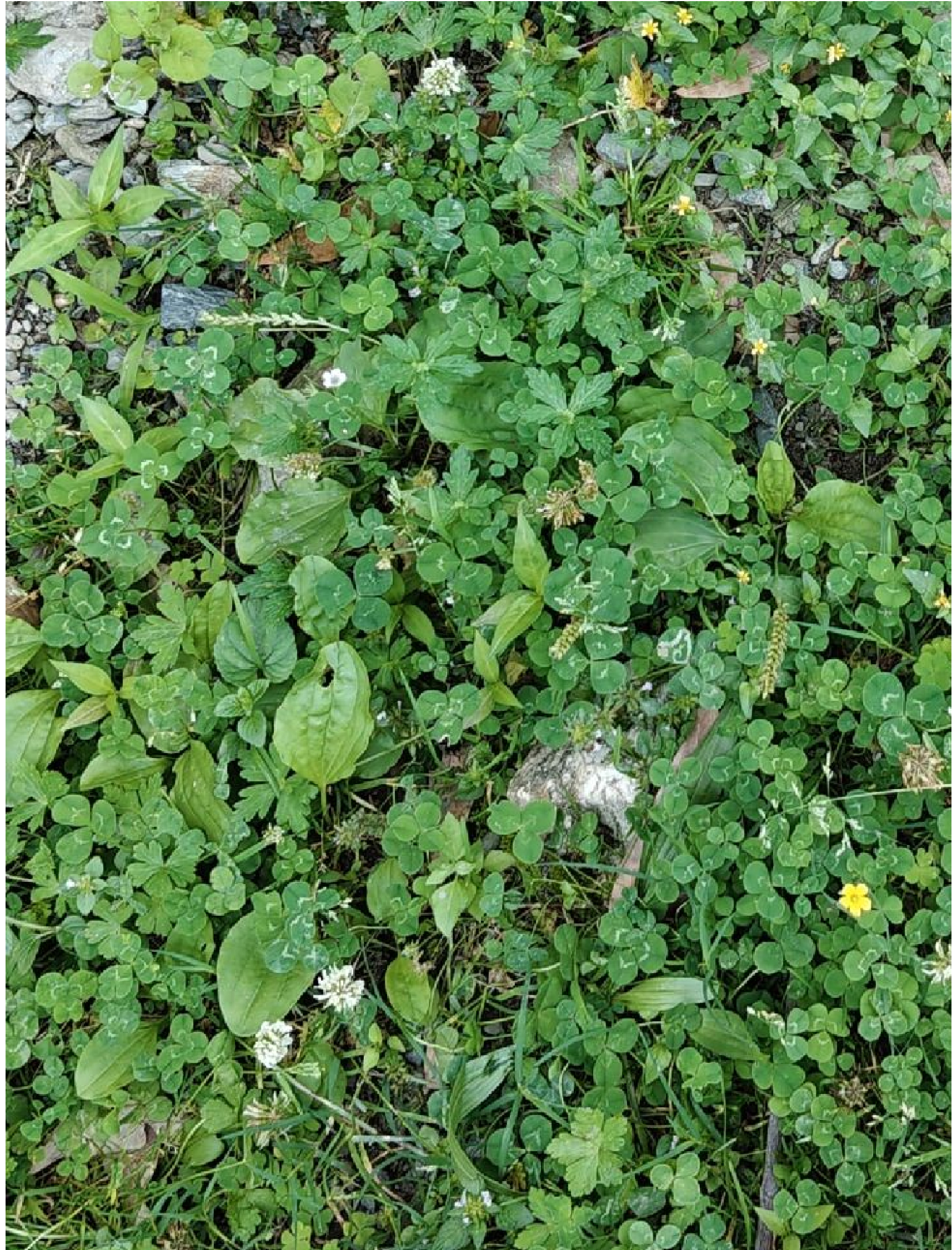
Trifolium repens
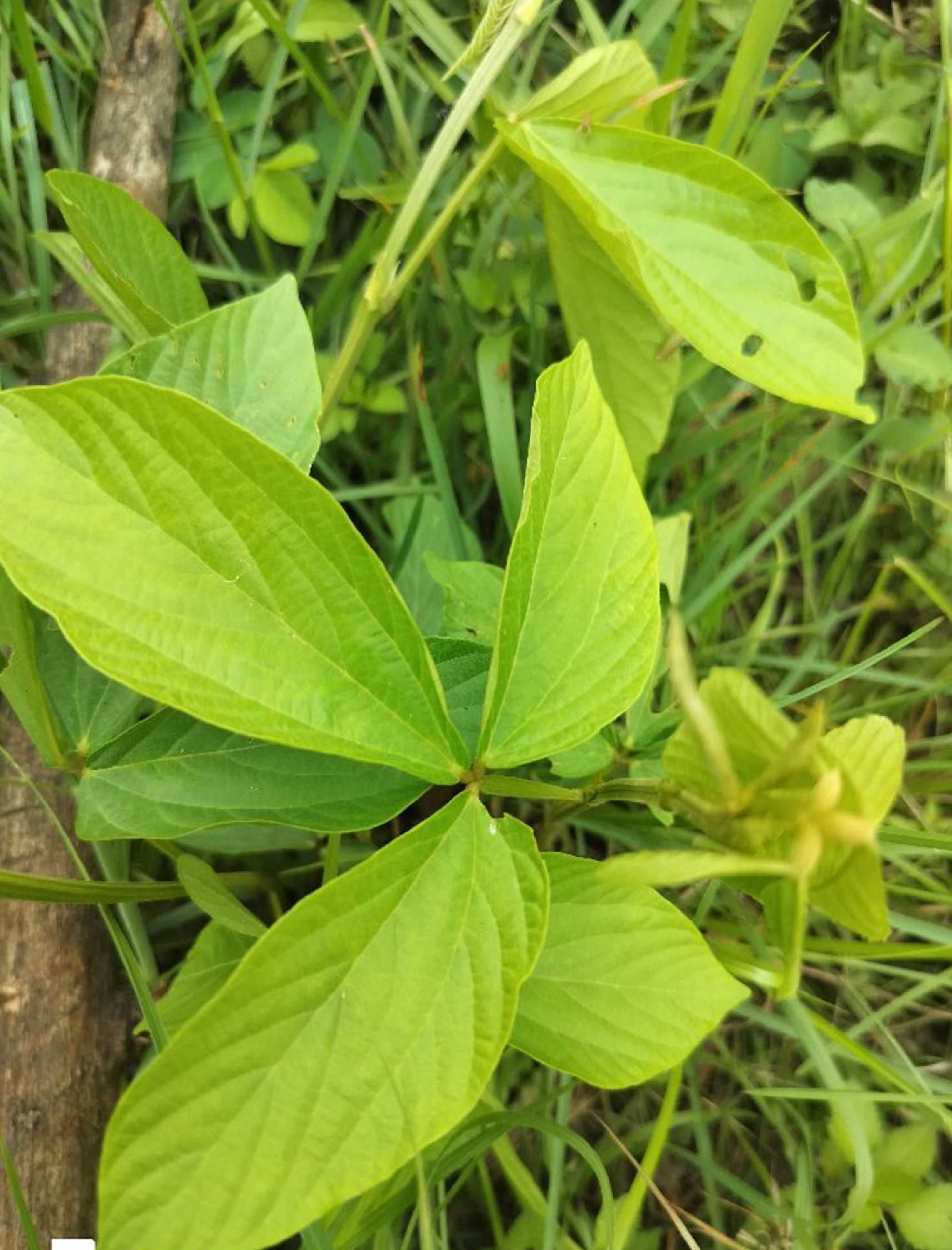
Vigna unguiculata
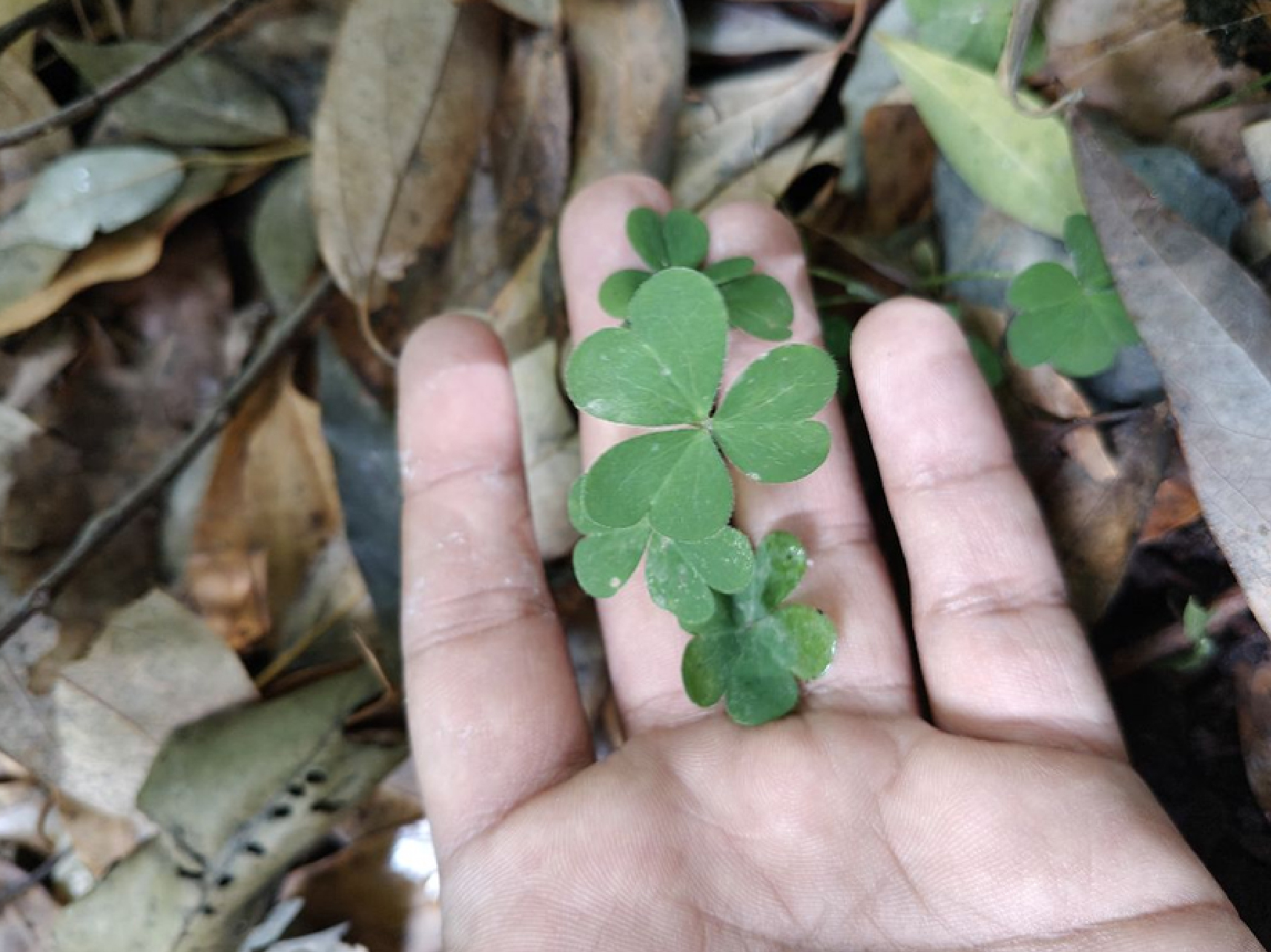
Oxalis corniculata
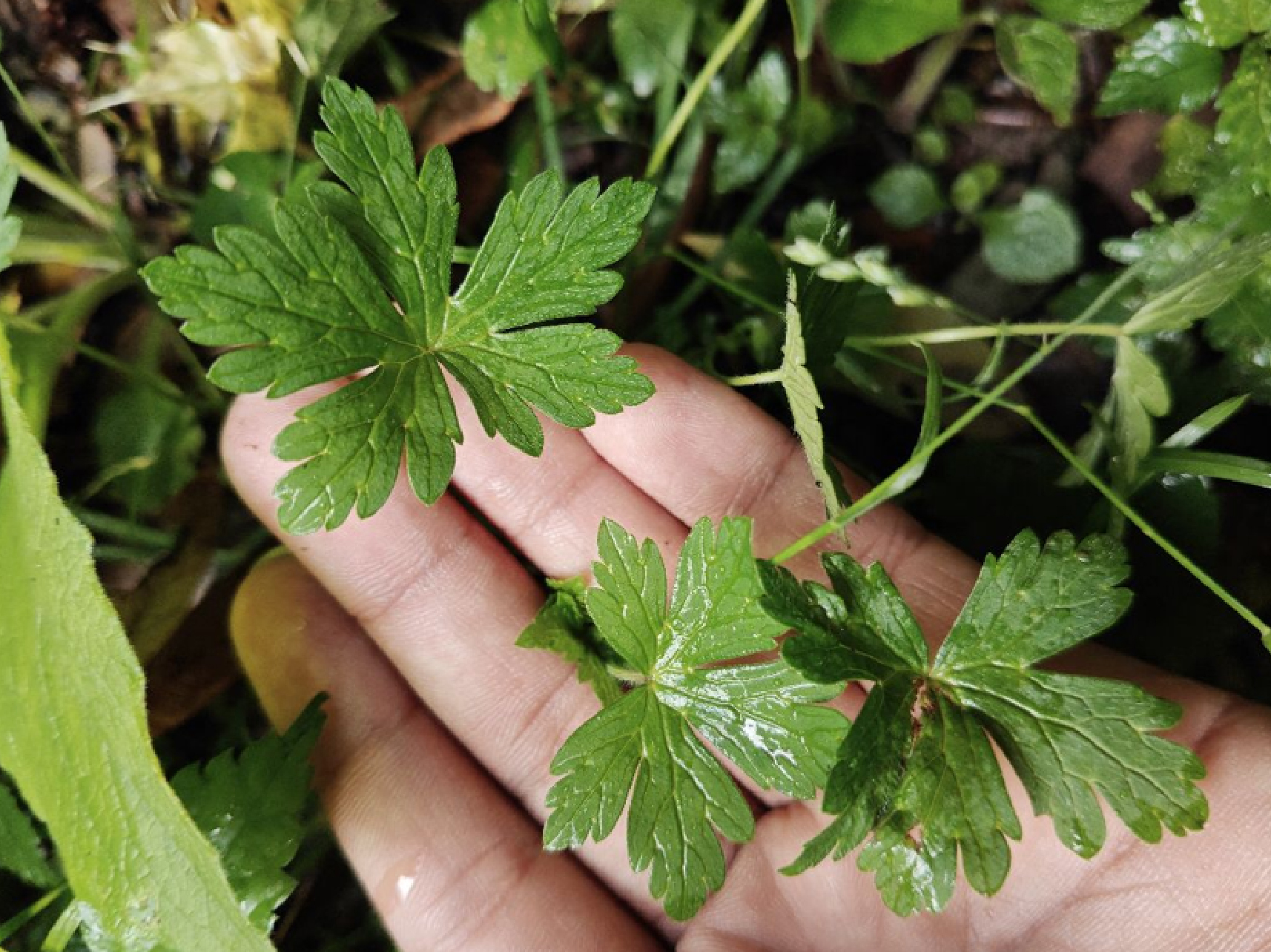
Geranium nepalense
Native herbs such as Trifolium repens, Vigna unguiculata, Oxalis corniculata, and Geranium nepalense. continue to thrive in a few
intact, moist plots with stable canopies and low disturbance. These
species once dominated mid-elevation oak and oak-pine understorey
zones, contributing to high ground cover, fast litter turnover, and
healthy soil conditions. However, they are now disappearing from
most surveyed sites replaced by exotic invasives. This shift from
diverse functional herb layers to disturbance-tolerant dominance
reflects a broader ecological transition driven by canopy thinning, soil
compaction & moisture loss across the landscape.
populations had far fewer flower heads than
before, dropping by more than half compared to 2015,
and also senesced early, ending its season by mid-June,
its flowering window shortened by over two weeks, likely
due to the intense March to May heat. Medicago lupulina in Pilang set seed almost three weeks earlier
than expected, peaking in early May instead of early
June, but dried up fast with the early rains. It has now
nearly vanished from most Pilang plots. Near Chamoli, Valeriana jatamansi barely showed up below 2200 m
and local monitors reported flowering either missing or
delayed by nearly a month, many saying the plant may
have disappeared from lower belts altogether. Leaf
flushing is earlier in Ajuga and Phoenix. In upper Dungra, Ajuga integrifolia flushed leaves about four weeks ahead
of schedule, but flower spikes were mostly absent in
over 80 % of plots. So it grew leaves but skipped flowering entirely. In Sidoli, Phoenix dactylifera began
leafing out in late February, over a month early
compared to before 2020, but no fruits set in over 70%
of plots, perhaps due to moisture stress and cold night
temperatures.
This is a typical balanced oak–pine mixed forest, with high species
diversity and healthy understorey vegetation. These habitats retain
soil moisture well and support a rich layer of native herbs and shrubs.
Litter decomposes rapidly due to active microbial processes with a
higher soil organic carbon. Bulk density stays moderate (around 1.1–
1.2 g/cm³) indicating that the soil is safe from compaction.
The ruderal Urtica and Opuntia display stress adapted behaviour. In Sidoli in the last few years Urtica dioica had
leaf size and height much reduced, even in richer soils,
and faded by the end of April, a month earlier than
expected. But it still shows up all over trail edges and
disturbed sites, suggesting it’s able to spread in exposed
spots even when stressed. Opuntia in Pilang began
budding in early April, nearly a month ahead of normal
and in some patches, it flowered twice, in April and
again in September. This two-time blooming seems to
be its way of coping with climate stress, and it now
covers many abandoned maize fields and dry fallows.
The data only affirms what villagers had sensed all
along. Plant groupings are falling apart; familiar pairings
no longer hold. It's not the same herbs or grasses, not
the same scent in the soil. Neither is the same leafing rhythm. The oak no longer sets the seasonal clock & the
vegetation no longer responds in the same way when the rain sets in.
